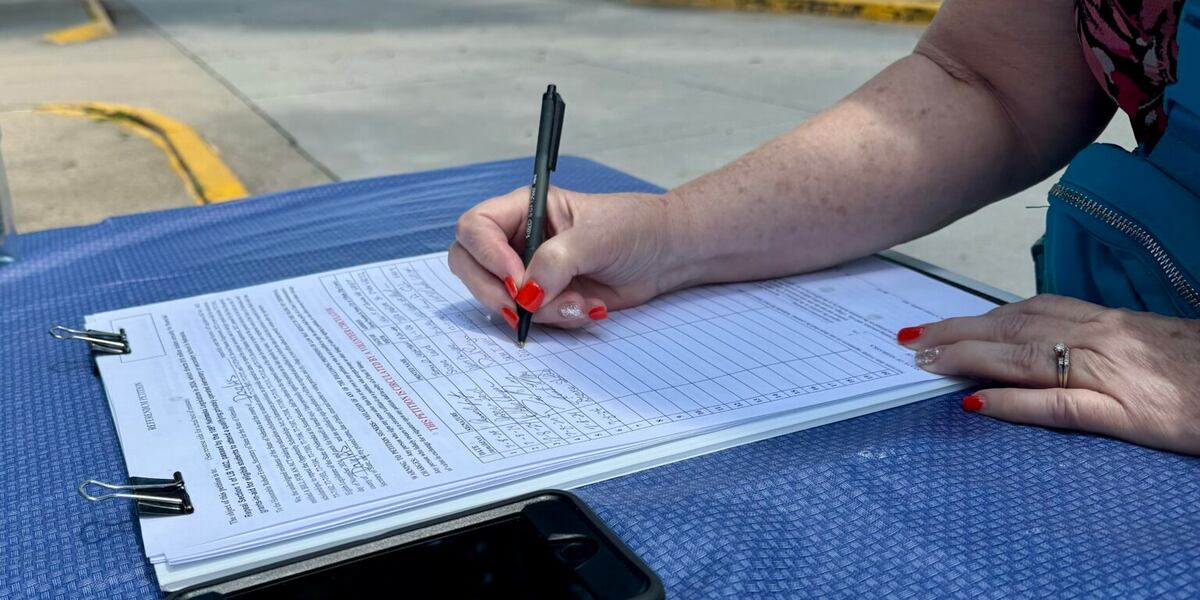Lifestyle
In 'Kinds of Kindness,' the cruelty is the point : Pop Culture Happy Hour


Lifestyle
Jeff VanderMeer painted a grotesque picture of climate change. Now he’s back for more

You know how in the Star Wars prequels, you learn how midi-chlorians sort of explain Jedi powers? Or how The Silmarillion explained all the history and lore of the Lord of the Rings trilogy? Don’t expect those types of concrete answers from the new novel Absolution.
“I’ve never really been into the idea of ‘lore,’” said author Jeff VanderMeer in an interview.
Absolution is the follow-up to VanderMeer’s wildly popular 2014 Southern Reach trilogy. Starting with Annihilation, the books told the story of Area X — a bit of land cut off from the rest of the continent, where nature has taken over. It’s lush with vegetation and wildlife, and it’d be beautiful except that weird and bad things tend to happen to people who enter. They get sick. They die. Or, they turn into creepy crawly creatures.
The atmospheric novels got rave reviews. Annihilation was adapted into a movie by director Alex Garland. And VanderMeer became a poster child for weird horror fiction that dealt directly with climate change. The new book, Absolution, with its eerie alligator experiments and grotesque depictions of skin suits, won’t change that. But VanderMeer isn’t too keen on being labeled a “climate-fiction” writer. “It’s hard for me to see climate fiction as a speculative endeavor,” he said. “It seems useful to try to avoid that categorization to some degree so that people can see novels for the totality of what they are.”

In the original trilogy, the Southern Reach is the government agency tasked with exploring Area X. It’s probably not a major spoiler to say that it doesn’t go well. And you find out that the Southern Reach is a bit of a mess. Actually, VanderMeer says a lot of his writing is about systems and institutions going haywire. He traces his interest in the theme back to an old day job doing software implementation, working for “a lot of companies that were like Lord of the Flies with middle management. And then dealing with government agencies, seeing just how ritualistic they were.”
It’s easy to make the allegorical jump from the Southern Reach trilogy to our institutional problems in dealing with (and causing) climate change. A bunch of critics and academics did. “It’s certainly thinking a lot about toxicity, forms of pollution, contamination and mutations,” said Alison Sperling, assistant professor of English at Florida State University. Sperling specializes in environmental fiction and has seen the field try and grapple with the utility of climate fiction. She often sees the question, “Can climate fiction save the planet?” And while she gets the motive, it’s not the right question for her.

“Weird fiction and weird eco-fiction, like [VanderMeer’s] kind of quite explicitly refuses to offer certain forms of answers or certain ways we’re supposed to respond. It serves as a refusal of that,” Sperling said.
Absolution continues to refuse to offer any answers. You obviously don’t get to the end of the book and suddenly realize the solution to climate change. You barely even get any answers to “What the heck is Area X, anyway?” But the answers aren’t the point. It’s how terrifying the questions are.

Lifestyle
6 things to know about L.A.'s new Balloon Museum, a place to dive into psychedelic art

You won’t find any clowns at the L.A. leg of the traveling Balloon Museum, but there are plenty of other carnival-inspired sights and sounds to be experienced: massive inflated tents, queue lines marked by bright primary colors and concessions fit for the midway.
The award-winning contemporary art museum unveiled its “Let’s Fly” show last week for a limited run at the Arts District’s Ace Mission Studios, which previously housed the fantastical amusement park Luna Luna.
Founded in Rome in 2020, the museum has welcomed more than 4.4 million visitors at its runs in cities across the globe, including Paris, Milan, Madrid, London, New York, Atlanta and Miami, among others. Each iteration is informed by the culture of the city hosting it, with the sole central medium of air.
A cross between the sensory explosion of Meow Wolf and the labyrinthine nature of an IKEA store, the experience features installations from 21 artists with avant-garde interpretations of inflatable and balloon art. On view through March 16, the exhibition is highly immersive and highly Instagrammable. Here are six things to know before you visit.
1. The experience begins even before you enter the building
The Sixth Street Viaduct stands in the background of the outdoor exhibit “D.R.E.A.M.S.” by artist Camila Falsini.
(Genaro Molina / Los Angeles Times)
The museum opens with a walk through the gardens — more specifically, Camila Falsini’s “D.R.E.A.M.S.,” a series of oversized inflatable shapes, symbols and igloos meant to evoke a dreamlike city inspired by Pop art and the Memphis Group.
The works, created specially for the L.A. “Let’s Fly” exhibition, are striped, spotted, shaped like doughnuts and light up in the night sky like condensed, dirigible versions of Ugo Rondinone’s “Seven Magic Mountains” sculpture.
Just inside, Max Streicher’s “Quadriga” stages massive billowing horses that call to mind wingless Pegasi the way they seem to gallop through the air. And the installations continue all the way through the gift shop, which is situated between a series of photo backdrops and a food court offering concessions like popcorn and cotton candy.
2. The strongest common thread between the works is not balloons but air

Maristella Burchietti is immersed in the exhibit “AI Data Portal of Los Angeles” by the Ouchhh collective.
(Genaro Molina / Los Angeles Times)
One might not immediately make the connection between data and air, but Ouchhh collective’s “AI Data Portal of Los Angeles,” an immersive tunnel of LED screens broadcasting an abstract amalgamation of Excel spreadsheets, documents, graphs and other digital ephemera, reimagines the city’s cloud data as thousands of tiny colored beads. The room, which has a dizzying effect, is reminiscent of Yayoi Kusama’s “Infinity Mirror Rooms” at the Broad but looks more like something out of Ant-Man’s quantum universe.
Another exhibit, the museum’s newest work, “Mariposa” by Oakland-based LED artist Christopher Schardt, features a massive flapping butterfly powered by a swinging bench and illuminated by more than 39,000 full-color LEDs. The most balloon-like, airy element of this room is the plush bean bags, on which guests are encouraged to recline and relax.
3. You’ll want to relive your childhood by diving into the massive ball pit

The “Hyperstellar” exhibit, created by Hyperstudio, Quiet Ensemble and Roman Hill, is one of many interactive art spaces.
(Genaro Molina / Los Angeles Times)
There are many great and memorable exhibits in the museum, but perhaps the pièce de résistance is the massive Olympic pool-sized ball pit that hosts intermittent light shows in which additional balls and spotlights descend from the already bulbous ceiling. If Matthew McConaughey’s “Interstellar” astronaut stumbled upon a planet dominated by palm-sized black balls, it might look something like this.
In fact, “Hyperstellar,” from Hyperstudio with Quiet Ensemble and Roman Hill, is meant to evoke musings about the cosmos, with the surrounding walls wrapped with LED screens broadcasting 360-degree views of exploding water droplets and air bubbles.
4. If you’re light-sensitive, beware of The Ginjos

“The Ginjos” exhibit by Rub Kandy is one of the more intense spaces in the museum.
(Genaro Molina / Los Angeles Times)
While there are many rooms inside the museum that appeal to one’s senses of touch, sound and sight (including a dimly lit bubble room with wet, squishy floors), visitors at risk of seizures should avoid “The Ginjos,” an installation filled with strange inflatable creatures that are something like Minions on acid.
Even the museum’s description, which describes Rub Kandy’s creations have “huge eyes that see everything,” is mildly creepy. Add to it pulsing strobe lights and floppy, oversized, mouthless cyclopes and you have all the makings of a nightmare trip. Speaking of trips …
5. Consider visiting the museum a little buzzed
Another “Let’s Fly” exclusive, ENESS’ “Spiritus Sonata,” features hallucinogenic, elephant-balloon hybrids that are straight out of Winnie the Pooh’s psychedelic “Heffalumps and Woozles” scene. Imagine mastodon-like creatures whose noses are wind instruments that inflate the structures and emit sound.
While there were makeshift wine bars intermittently set up throughout the space during the media preview, it’s unclear whether the museum will provide provisions for the general public. But patrons who partake before arriving will definitely have a heightened experience in the trippy rooms.
6. Wear something Instagrammable — there’s a selfie opp by the exit!

Maristella Burchietti stands in one the museum’s selfie spots.
(Genaro Molina / Los Angeles Times)
No modern museum is complete without plenty of social media-ready photo opportunities, and the Balloon Museum saves the best for last.
In the museum’s final corridor — just past a VR headset experience and before the gift shop and food court — are situated eight jewel-toned cubicles staged with props for the perfect minimally decorated but vividly hued Instagram post.
Choose between a massive headless gummy bear, a balloon-filled phone booth, a cloudscape, L.A.-ready angel wings and other poppy backdrops for a one-of-a-kind photo experience. Because if it’s not posted on Instagram, did you even go?
Lifestyle
In 'The Penguin' a C-list villain gets an A-list series : Pop Culture Happy Hour

Colin Farrell as Oswald Cobb in The Penguin.
HBO
hide caption
toggle caption
HBO

Colin Farrell as Oswald Cobb in The Penguin.
HBO
In the HBO new series The Penguin, an unrecognizable Colin Farrell reprises his role as Oswald Cobb from The Batman. This time though, the caped crusader is nowhere to be found. Instead, we’ve got an unexpectedly fresh take on Gotham, and a crackling turf war involving the vengeful daughter of a crime boss, played by Cristin Milioti.
Subscribe to Pop Culture Happy Hour Plus at plus.npr.org/happyhour
-

 Sports1 week ago
Sports1 week agoFreddie Freeman's walk-off grand slam gives Dodgers Game 1 World Series win vs. Yankees
-
News1 week ago
Sikh separatist, targeted once for assassination, says India still trying to kill him
-

 Culture1 week ago
Culture1 week agoFreddie Freeman wallops his way into World Series history with walk-off slam that’ll float forever
-

 Technology1 week ago
Technology1 week agoWhen a Facebook friend request turns into a hacker’s trap
-
Business3 days ago
Carol Lombardini, studio negotiator during Hollywood strikes, to step down
-

 Health4 days ago
Health4 days agoJust Walking Can Help You Lose Weight: Try These Simple Fat-Burning Tips!
-
Business2 days ago
Hall of Fame won't get Freddie Freeman's grand slam ball, but Dodgers donate World Series memorabilia
-

 Business7 days ago
Business7 days agoWill Newsom's expanded tax credit program save California's film industry?


















